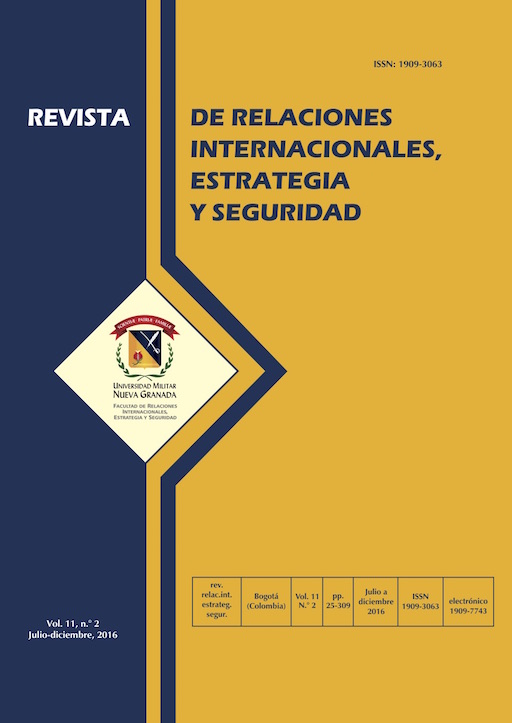Las relaciones en el golfo después de la “primavera árabe” y su impacto en la región
Resumen
La “Primavera Árabe” no sólo ha tenido consecuencias en el plano local, sacudiendo a los países directamente afectados, sino que también ha impactado en las relaciones regionales. En este contexto, Arabia Saudita, Emiratos Árabes Unidos y Qatar fueron protagonistas de una fuerte disputa en torno al rol regional del Islam político, particularmente de los Hermanos Musulmanes. El artículo se pregunta cuáles fueron las condiciones de posibilidad y los efectos de esta disputa, proponiéndose efectuar un recorrido exploratorio a través de una lectura no sectaria de los conflictos que siguieron a la “Primavera Árabe”. Así, en el marco de la intensificación de una cada vez mayor participación del intervencionismo en la política internacional, la inexistencia de una comunidad de seguridad entre los países analizados los condujo a resolver sus conflictos a través de guerras proxy en los distintos escenarios nacionales. En éstas, Doha apoyó a las distintas ramas de la mencionada agrupación, mientras que Riad y Abu Dabi hicieron lo propio con las fuerzas enfrentadas a ella. De este modo, el artículo concluye que la disputa entre los países mencionados contribuyó a la exacerbación y a la profundización de los distintos conflictos en los países afectados por los levantamientos.Descargas
Lenguajes:
esAgencias de apoyo:
Consejo Nacional de Investigaciones Científicas y Técnicas (CONICET), ArgentinaReferencias bibliográficas
Abbink, J. (2003). Ethiopia—Eritrea: Proxy Wars and Prospects of Peace in the Horn of Africa. Journal Of Contemporary African Studies, 21(3), 407-426.
Abdullah, A. (2012). Repercussions of the Arab Spring on GCC States (1st ed.). Doha: Arab Center for Research and Policy Studies.
Adler, E., & Barnett, M. (1998). Security Communities. Cambridge, UK: Cambridge University Press.
Ahmed, A. (2015, 17 de junio). Obama Brokered a Secret Deal Between 2 Arab States that Could Help End Libya’s Civil War. The Huffington Post. Recuperado de http://www.huffingtonpost.com/2015/06/17/libya-peace-uae-qatar_n_7605898.html
Al-Arabiyya (2012, 25 de mayo). Islamists Plot against Gulf, Says Dubai Police Chief. Recuperado de https://english.alarabiya.net/articles/2012/03/25/203019.html
Al-Thani, T. (2013, 26 de junio). HE Tamim Speech. Recuperado de http://www.usqbc.org/uploads/files/NEW1_H_Tamim_Speech_2013(3).pdf.
Amirah Fernández, H. (2011). Relaciones internacionales del Golfo: intereses, alianzas, dilemas y paradojas. Revista ARI, (48), 1-7.
Amirah Fernández, H., & Fernández Gómez, M. (2015). El Golfo y su creciente intervencionismo en Oriente Medio. Revista Elcano, (7), 58-65.
Annan, K. (1999, 18 de septiembre). Two Concepts of Sovereignty. The Economist. Recuperado de http://www.economist.com/node/324795
Ashour, O. (2012). Libyan Islamists Unpacked: Rise, Transformation and Future. Brookings Doha Center. Recuperado de http://www.brookings.edu/research/papers/2012/05/02-libya-ashour
Bahrain News Agency (2014, 5 de marzo). Bahrain, Saudi Arabia, UAE Issue Joint Statement. Recuperado de http://www.bna.bh/portal/en/news/606640
Bar-Siman-Tov, Y. (1984). The Strategy of War by Proxy. Cooperation And Conflict, 19(4), 263-273.
Burke, E. (2012). ‘One Blood and One Destiny?’ Yemen´s Relation with the Gulf Cooperation Council. Kuwait Programme on Development, Governance and Globalization, London School of Economics, Research paper.
Buzan, B. y Hansen, L. (2009). The Evolution of International Security Studies. New York: Cambridge University Press.
Cuadro, M. (2013). Guerra y liberalismo. Revista Relaciones Internacionales, 22(44), 15-40.
Dagher, S.; Levinson, C. y Coker, M. (2011, 17 de octubre). Tiny Kingdom’s Huge Role in Libya Draws Concern. The Wall Street Journal. Recuperado de http://www.wsj.com/articles/SB10001424052970204002304576627000922764650
Deutsch, K. et al. (1957). Political Community and the North Atlantic Area: International Organizations in the Light of Historical Experience. New Jersey: Princeton University Press.
Deutsch, K. (1964). External Involvement in Internal Wars. En H. Eckstein, Internal War: Problems and Approaches (1st ed., pp. 100-110). New York: Free Press of Glencoe.
Dorsey, J. (2013, 8 de septiembre). Wahhabism vs. Wahhabism: Qatar Challenges Saudi Arabia. Middle East Online. Recuperado de http://www.middle-east-online.com/english/?id=61189
Dorsey, J. (2014, 2 de octubre). Gulf Proxy War: UAE Seeks to Further Damage Qatar´s Already Tarnished Image. Daily News Egypt. Recuperado de http://www.huffingtonpost.com/james-dorsey/gulf-proxy-war-uae-seeks_b_5898246.html
Duner, B. (1981). Proxy Intervention in Civil Wars. Journal Of Peace Research, 18(4), 353-361.
Foley, S. (1999). The UAE: Political Issues and Security Dilemmas. Middle East Review Of International Affairs, 3(1), 25-45.
Foucault, M. (2004). Securité, Territoire, Population. Paris: Gallimard.
George, J., & Campbell, D. (1990). Patterns of Dissent and the Celebration of Difference: Critical Social Theory and International Relations. International Studies Quarterly, 34(3), 269-293.
Hajri, R. (2014, 5 de agosto). UAE Tries to Scuttle Qatar-Saudi Reconciliation. Al-Monitor. Recuperado de http://www.al-monitor.com/pulse/originals/2014/08/saudi-qatari-rapprochement-uae-threat-gulf-reconciliation.html
Hearst, D. (2014, 2 de octubre). Was the UAE Behind the Houthi Takeover of Sana’a? Middle East Monitor. Recuperado de http://www.middleeasteye.net/news/was-uae-behind-houthi-takeover-sanaa-1340168724
Hearst, D. (2015, 1 de enero). A Saudi Palace Coup. The World Post. Recuperado de http://www.huffingtonpost.com/david-hearst/a-saudi-palace-coup_b_6531246.html
Hegghamer, T. (2004). Saudi Arabia Backgrounder: Who are the Islamists? ICG Middle East Report, (31). Recuperado de http://www.crisisgroup.org/en/regions/middle-east-north-africa/iraq-iran-gulf/saudi-arabia/031-saudi-arabia-backgrounder-who-are-the-islamists.aspx
Hurd, E. S. (2008). The Politics of Secularism in International Relations, New Jersey: Princeton University Press.
International Commission on Intervention and State Sovereignty,. (2001). The Responsibility to Protect. Toronto: Canadian Ministry of Foreign Affairs.
Janardhan, N. (2013). Regionalisation and Omni-balancing in the Gulf. En A. Echagüe, The Gulf States and the Arab Uprisings. (1st ed., pp. 25-34). Cambridge: Fride and Gulf Research Center.
Kamrava, M. (2012). The Arab Spring and the Saudi-Led Counterrevolution. Orbis, 56(1), 96-104.
Karouny, M. (2013, 31 de mayo). Saudi Edges Qatar to Control Syrian Rebel Support. Reuters. Recuperado de http://www.reuters.com/article/us-syria-crisis-saudi-insight-idUSBRE94U0ZV20130531
Katzman, K. (2014). The United Arab Emirates (UAE): Issues for U.S. Policy. Washington: Library of Congress.
Khalaf, R. y Fielding, S. (2013, 16 de mayo). Qatar Bankrolls Syrian Revolt with Cash and Arms. Financial Times. Recuperado de http://www.ft.com/intl/cms/s/0/86e3f28e-be3a-11e2-bb35-00144feab7de.html#axzz40EhHnWFu
Khalid Hassan, I. (2015). GCC’s 2014 Crisis: Causes, Issues and Solutions. Doha: Al-Jazeera Center for Studies.
Megrisi, T. (2013, 9 de agosto). Libya´s House of Cards. Muftah. Recuperado de http://muftah.org/libyas-house-of-cards/#.VsG5svnhDcs
Muslimi, F. (2013, 20 de agosto). Qatar Encroaches on Saudi Influence in Yemen. Al-Monitor. Recuperado de http://www.al-monitor.com/pulse/originals/2013/08/qatar-encroaches-saudi-influence-yemen.html
Noaimi, A. (2012, 15 de octubre). Setting the Record Straight on Al-Islah in the UAE. Al-Monitor. Recuperado de http://www.al-monitor.com/pulse/originals/2012/al-monitor/uae-setting-the-record-straight.html#
Qatar Ministry of Foreign Affairs (2014). HE Qatari FM: Qatar Chooses Not to Remain on the Fringe of History. Recuperado de http://www.mofa.gov.qa/en/SiteServices/MediaCenter/News/Pages/News20140310215454.aspx
Qatar News Agency (2014, 5 de marzo). Qatar’s Cabinet Regrets Withdrawal of Ambassadors of Saudi Arabia, UAE and Bahrain from Doha. Recuperado de http://www.mofa.gov.qa/en/SiteServices/MediaCenter/News/Pages/News20140305171653.aspx
Rashed, A. (2013, 18 de agosto). Why is the Gulf divided over Egypt? Al-Arabiyya. Recuperado de http://english.alarabiya.net/en/views/news/middle-east/2013/08/18/Why-is-the-Gulf-divided-over-Egypt-.html
Rasheed, M. (2015, 2 de octubre). Saudi War in Yemen Impossible to Win. Al-Monitor. Recuperado de http://www.al-monitor.com/pulse/originals/2015/10/saudi-arabia-lose-protracted-war-yemen.html
Salama, S. (2014, 2 de abril). Qatar´s History of Turbulent Relations with the UAE. Gulfnews. Recuperado de http://gulfnews.com/news/uae/government/qatar-s-history-of-turbulent-relations-with-uae-1.1312739
Smith, S. (2004). Britain’s Revival and Fall in the Gulf. New York: Routledge.
Steinberg, G. (2013). Islamism in the Gulf. En A. Echagüe, The Gulf States and the Arab Uprisings (1st ed., pp. 59-68). Cambridge: Fride and Gulf Research Center.
Steinberg, G. (2014). Leading the Counter-Revolution. Saudi Arabia and the Arab Spring, Berlin: SWP Research Center.
Ulrichsen, K. (2013). Domestic Implications of the Arab Uprisings in the Gulf. En A. Echagüe, The Gulf States and the Arab Uprisings. (1st ed., pp. 35-46) Cambridge: Fride and Gulf Research Center.
Ulrichsen, K. (2014). Qatar and the Arab Spring. New York: Oxford University Press.
Verghese, N. (2014, 8 de septiembre). Libya: Where are the Dividing Lines? Al-Jazeera. Recuperado de http://www.aljazeera.com/news/middleeast/2014/09/libya-conflict-militias-dividing-lines-20149871934621546.html
Youngs, R. (2013). Living With the Middle East’s Old-New Security Paradigm. En Echagüe, The Gulf States and the Arab Uprisings. (1st ed. Pp. 15-24). Cambridge: Fride and Gulf Research Center.
Záccara, L., & Saldaña, M. (2015). Cambios y estabilidad política en las monarquías del Golfo tras la Primavera Árabe. Revista CIDOB D'afers Internationals, (109), 177-199.












